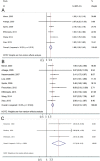Survival and prognostic factors in hypertrophic cardiomyopathy: a meta-analysis
- PMID: 28931939
- PMCID: PMC5607340
- DOI: 10.1038/s41598-017-12289-4
Survival and prognostic factors in hypertrophic cardiomyopathy: a meta-analysis
Abstract
Hypertrophic cardiomyopathy (HCM) is a clinically and genetically heterogeneous disorder but data on survival rates are still conflicting and have not so far been quantitatively reviewed. The aim of this study is to conduct a meta-analysis of cohort studies to assess pooled survival rates and prognostic factors for survival in patients with HCM. Nineteen studies were included representing 12,146 HCM patients. The pooled 1-, 3-, 5- and 10-year survival rates were 98.0%, 94.3%, 82.2% and 75.0%, respectively. Among patients with HCM, age, NYHA functional class, family history of sudden death (FHSD), syncope, atrial fibrillation, non-sustained ventricular tachycardia (nsVT), maximum left ventricular wall thickness and obstruction were significant prognostic factors for cardiovascular death. For sudden cardiac death, FHSD, nsVT, and obstruction showed significant predictive values. Moreover, estimation of population attributable risk (PAR) suggested that nsVT was the strongest predictor for cardiovascular death (13.02%, 95% CI 3.60-25.91%), while left ventricular outflow tract obstruction/mid-ventricular obstruction (LVO/MVO) was the strongest predictor for all-cause death and sudden cardiac death (10.09%, 95% CI 4.72-20.42% and 16.44%, 95% CI 7.45-31.55%, respectively). These risk factors may thus be useful for identifying HCM patients who might benefit from early diagnosis and therapeutic interventions.
Conflict of interest statement
The authors declare that they have no competing interests.
Figures




Similar articles
-
Sudden death in hypertrophic cardiomyopathy: old risk factors re-assessed in a new model of maximalized follow-up.Eur Heart J. 2010 Dec;31(24):3084-93. doi: 10.1093/eurheartj/ehq308. Epub 2010 Sep 15. Eur Heart J. 2010. PMID: 20843960
-
Prognostic value of non-sustained ventricular tachycardia and the potential role of amiodarone treatment in hypertrophic cardiomyopathy: assessment in an unselected non-referral based patient population.Heart. 1998 Apr;79(4):331-6. doi: 10.1136/hrt.79.4.331. Heart. 1998. PMID: 9616338 Free PMC article.
-
The prognostic importance of left ventricular outflow obstruction in hypertrophic cardiomyopathy varies in relation to the severity of symptoms.J Am Coll Cardiol. 2005 Apr 5;45(7):1076-80. doi: 10.1016/j.jacc.2004.12.067. J Am Coll Cardiol. 2005. PMID: 15808767
-
[Sudden cardiac death in familial hypertrophic cardiomyopathy. Identification of high-risk patients].Dtsch Med Wochenschr. 2005 May 6;130(18):1150-4. doi: 10.1055/s-2005-866802. Dtsch Med Wochenschr. 2005. PMID: 15856398 Review. German.
-
[Evaluation of the risk of sudden death in hypertrophic cardiomyopathy].Arch Mal Coeur Vaiss. 1999 Apr;92 Spec No 1:65-73. Arch Mal Coeur Vaiss. 1999. PMID: 10326160 Review. French.
Cited by
-
Palpitation was associated with clinical outcomes in patients with hypertrophic cardiomyopathy.Sci Rep. 2020 Sep 10;10(1):14935. doi: 10.1038/s41598-020-71797-y. Sci Rep. 2020. PMID: 32913229 Free PMC article.
-
Hypertrophic Cardiomyopathy Diagnosis and Treatment in High- and Low-Income Countries: A Narrative Review.Cureus. 2023 Oct 1;15(10):e46330. doi: 10.7759/cureus.46330. eCollection 2023 Oct. Cureus. 2023. PMID: 37916234 Free PMC article. Review.
-
Hypertrophic Cardiomyopathy in Saudi Arabia: A Systematic Review of the Epidemiological, Clinical, and Imaging Features.Curr Cardiol Rev. 2023;19(2):e250822208003. doi: 10.2174/1573403X18666220825153725. Curr Cardiol Rev. 2023. PMID: 36028969 Free PMC article.
-
The Complex Puzzle of Hypertrophic Phenotype: A Practical Approach for the Clinician.Arq Bras Cardiol. 2025 Mar;122(1):e20240529. doi: 10.36660/abc.20240529. Arq Bras Cardiol. 2025. PMID: 40197947 Free PMC article. Review. English, Portuguese.
-
Application of the ALBI Scoring System for Mortality Outcome Prediction in Patients with Hypertrophic Cardiomyopathy.Glob Heart. 2022 Oct 11;17(1):73. doi: 10.5334/gh.1163. eCollection 2022. Glob Heart. 2022. PMID: 36382161 Free PMC article.
References
-
- Sasaki T, Nakao S, Tanaka H. Hypertrophic cardiomyopathy. Ryoikibetsu Shokogun Shirizu. 1996;287:193–198. - PubMed
Publication types
MeSH terms
Grants and funding
LinkOut - more resources
Full Text Sources
Other Literature Sources

